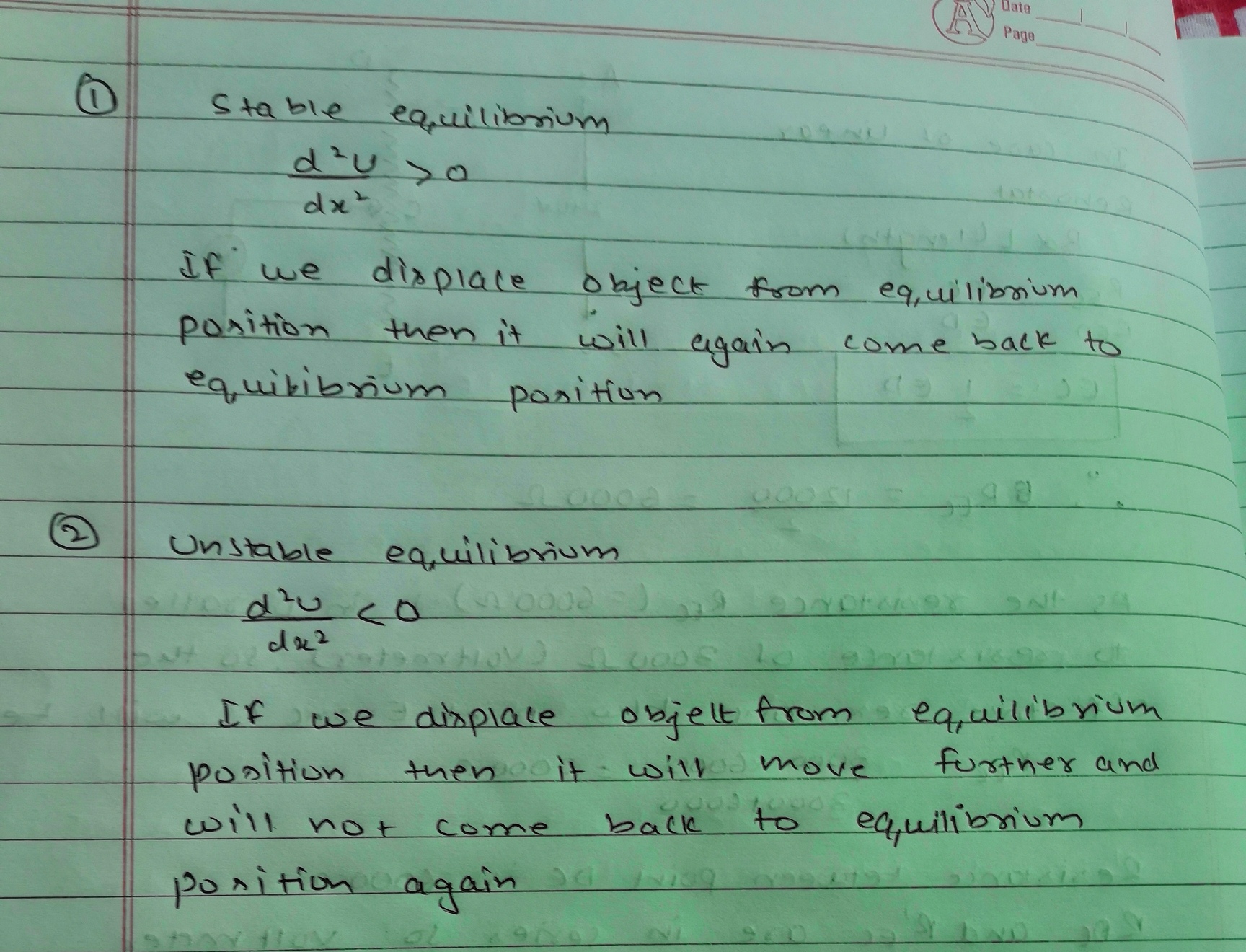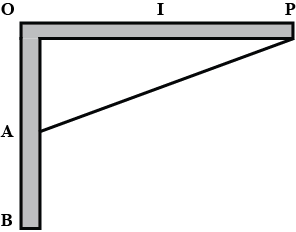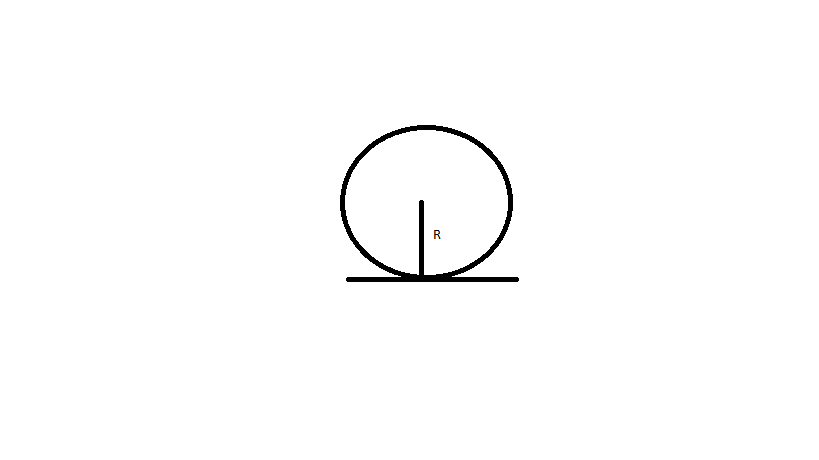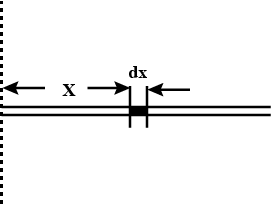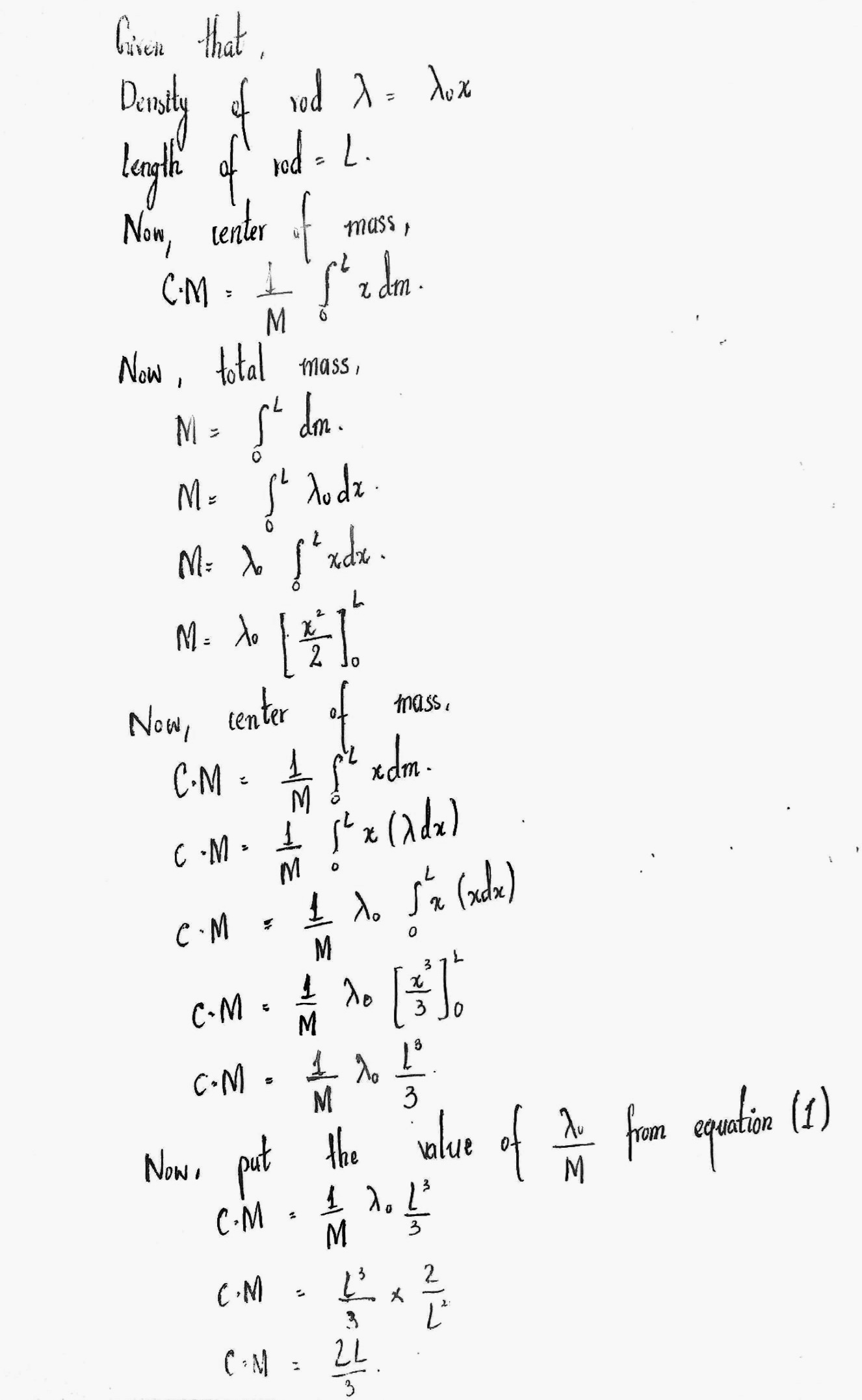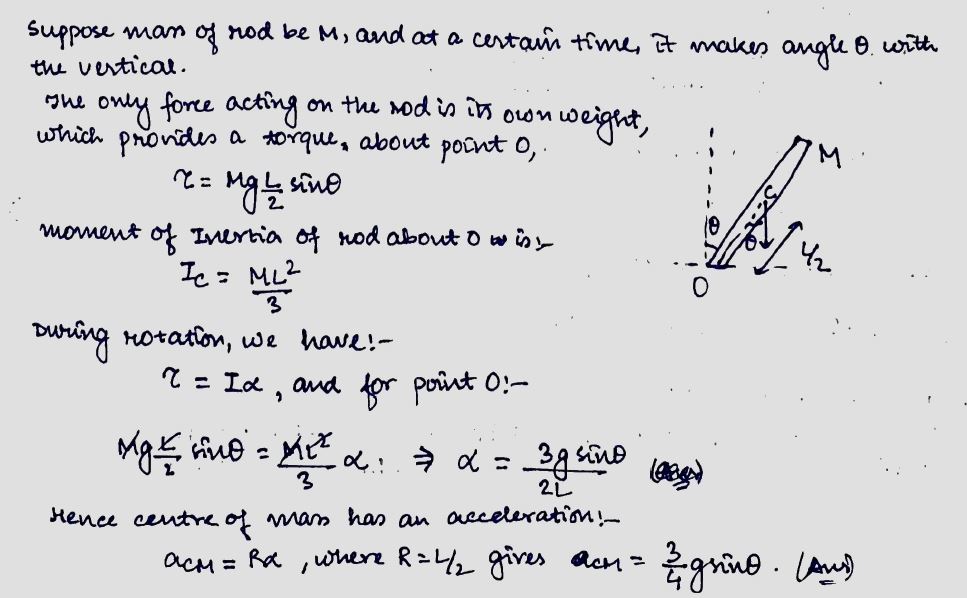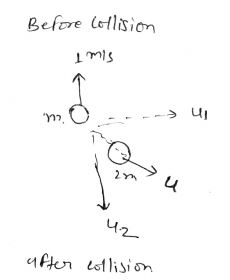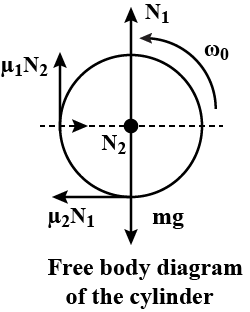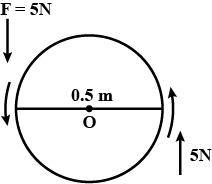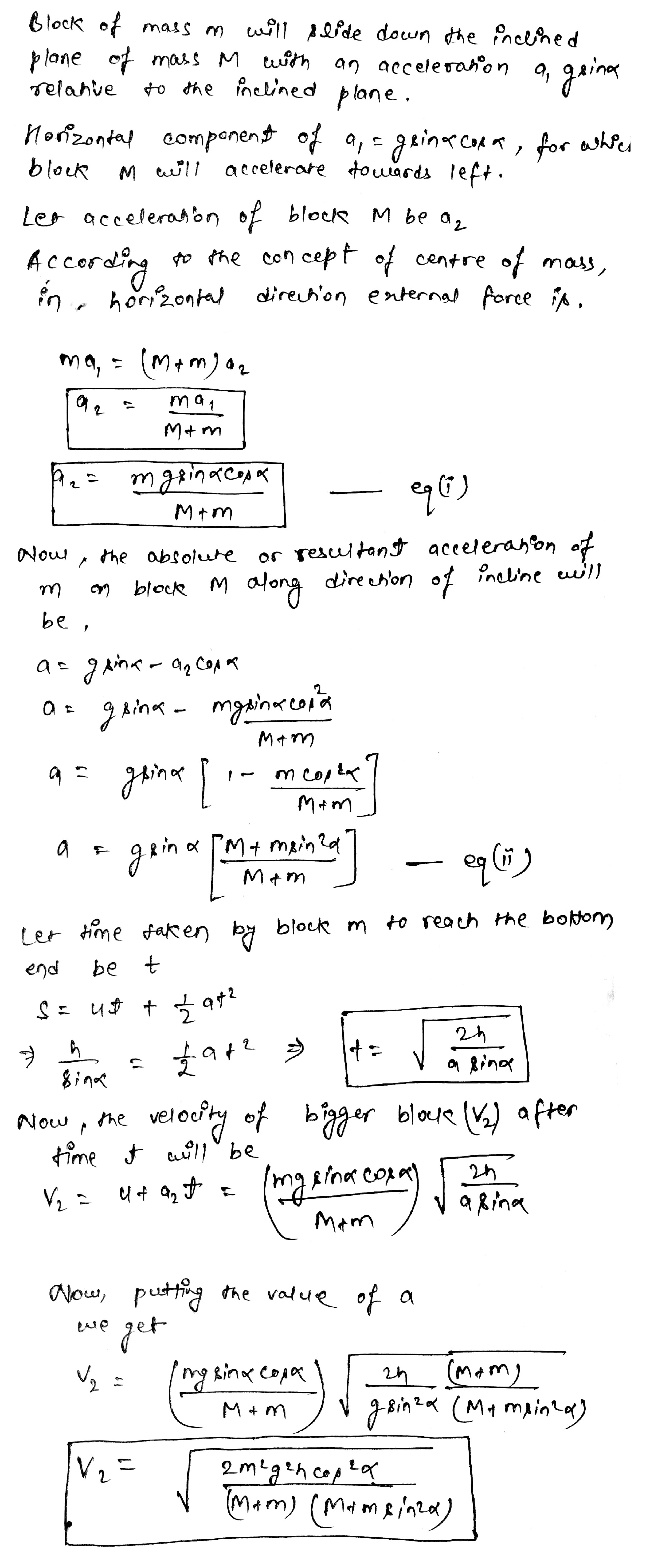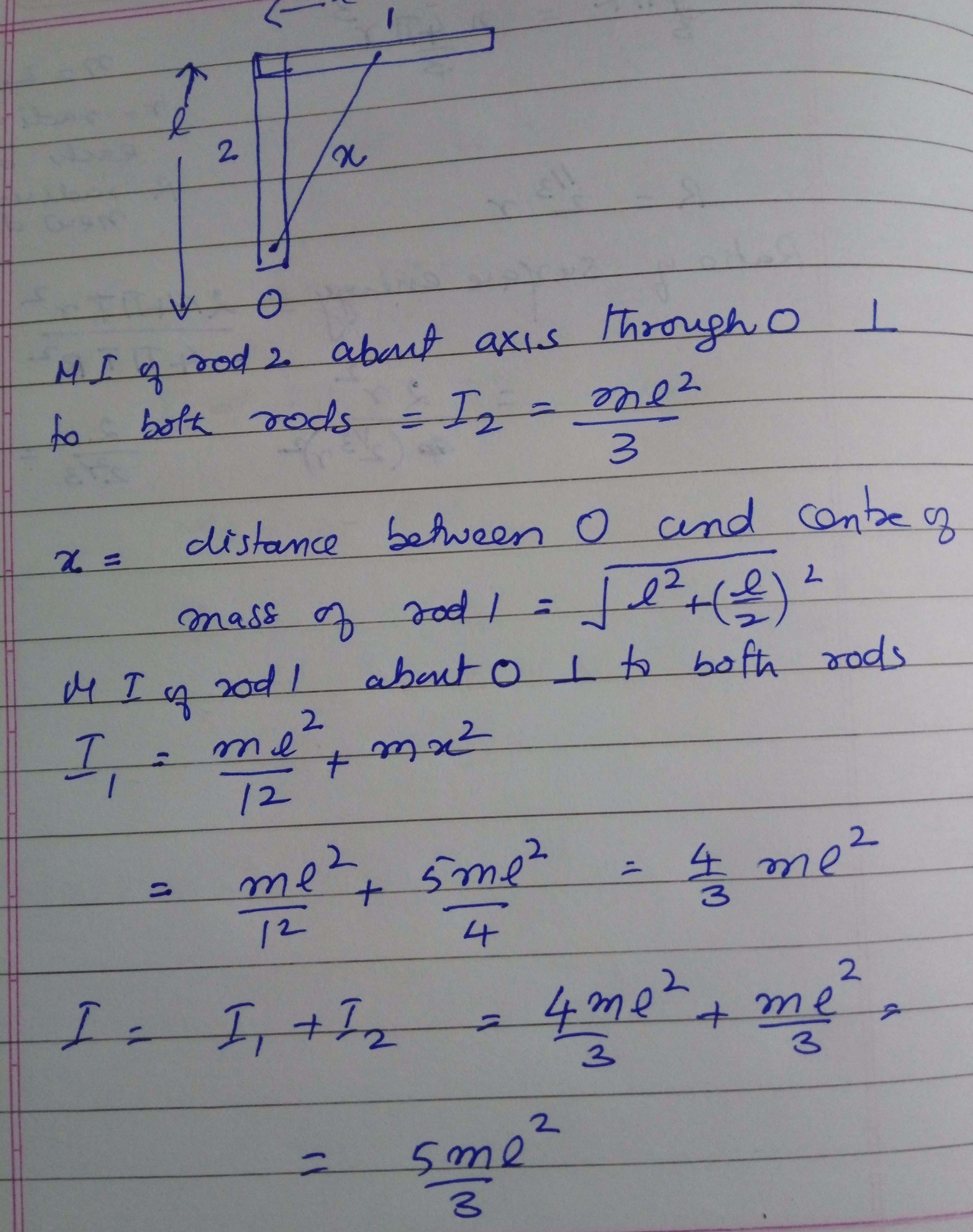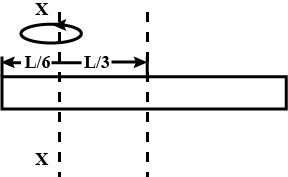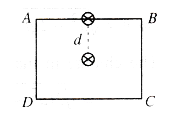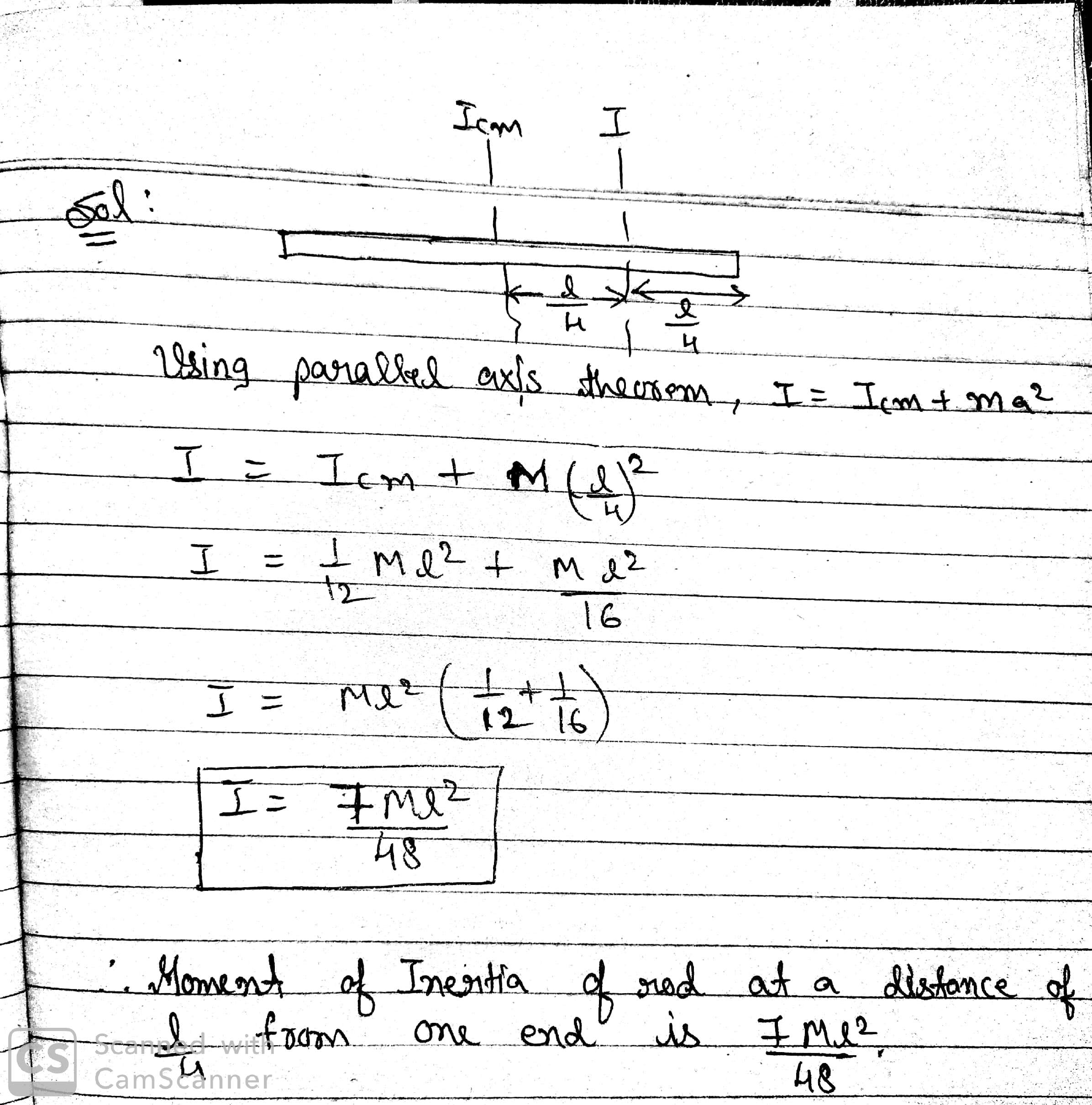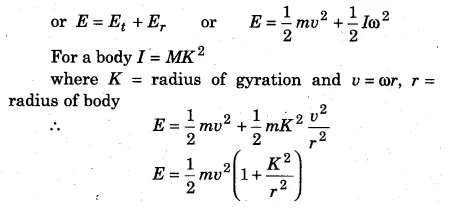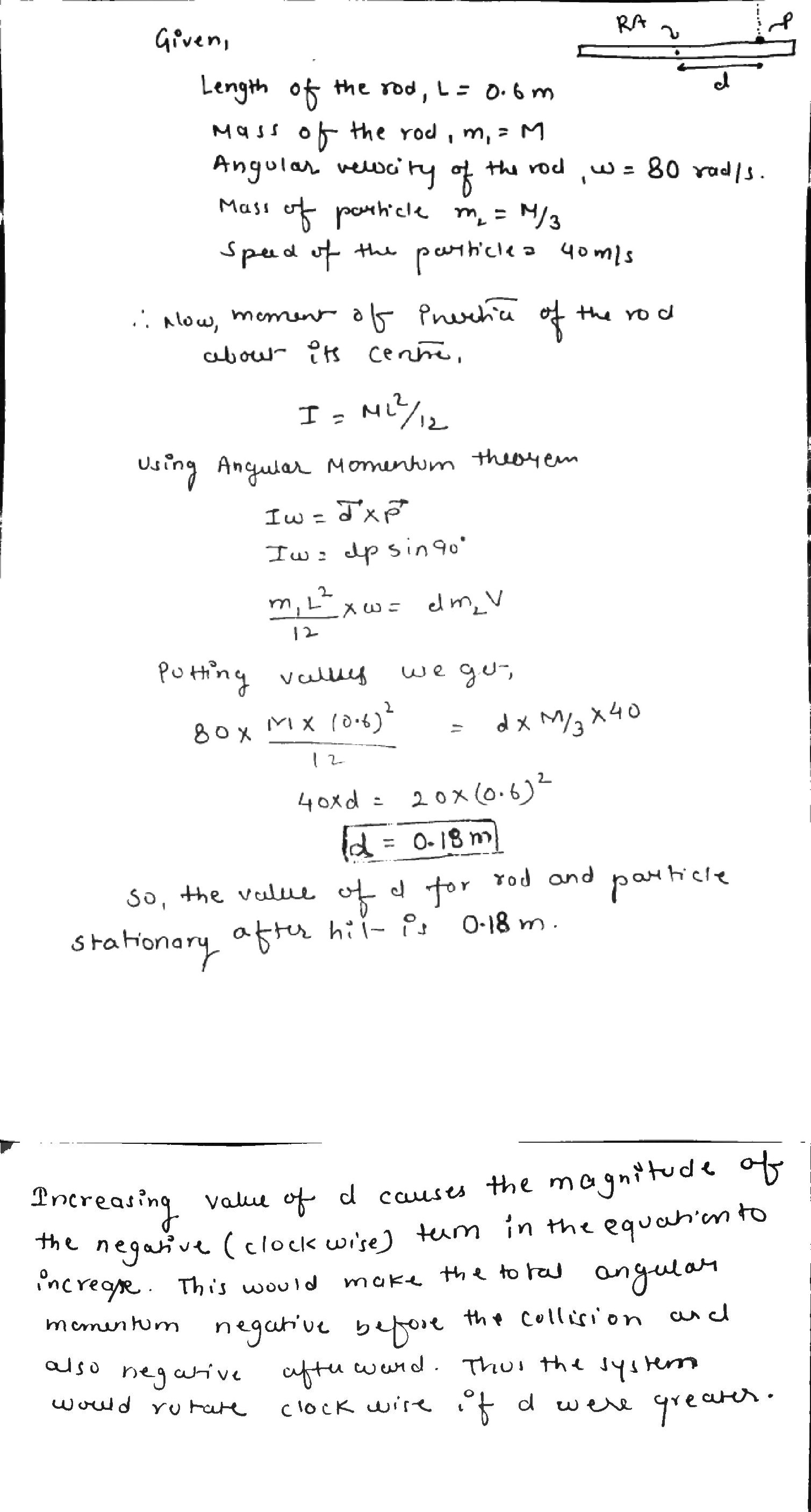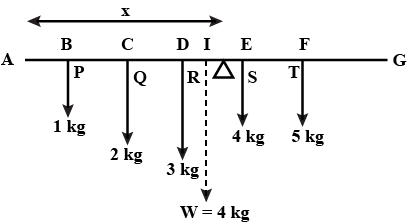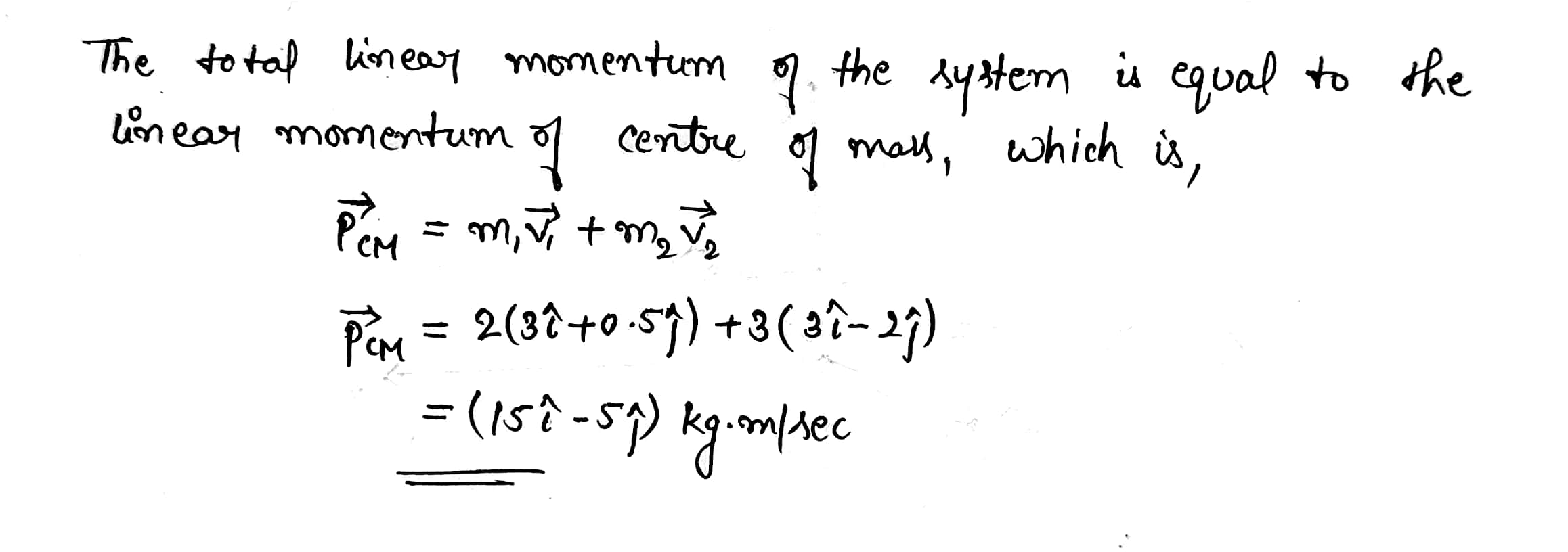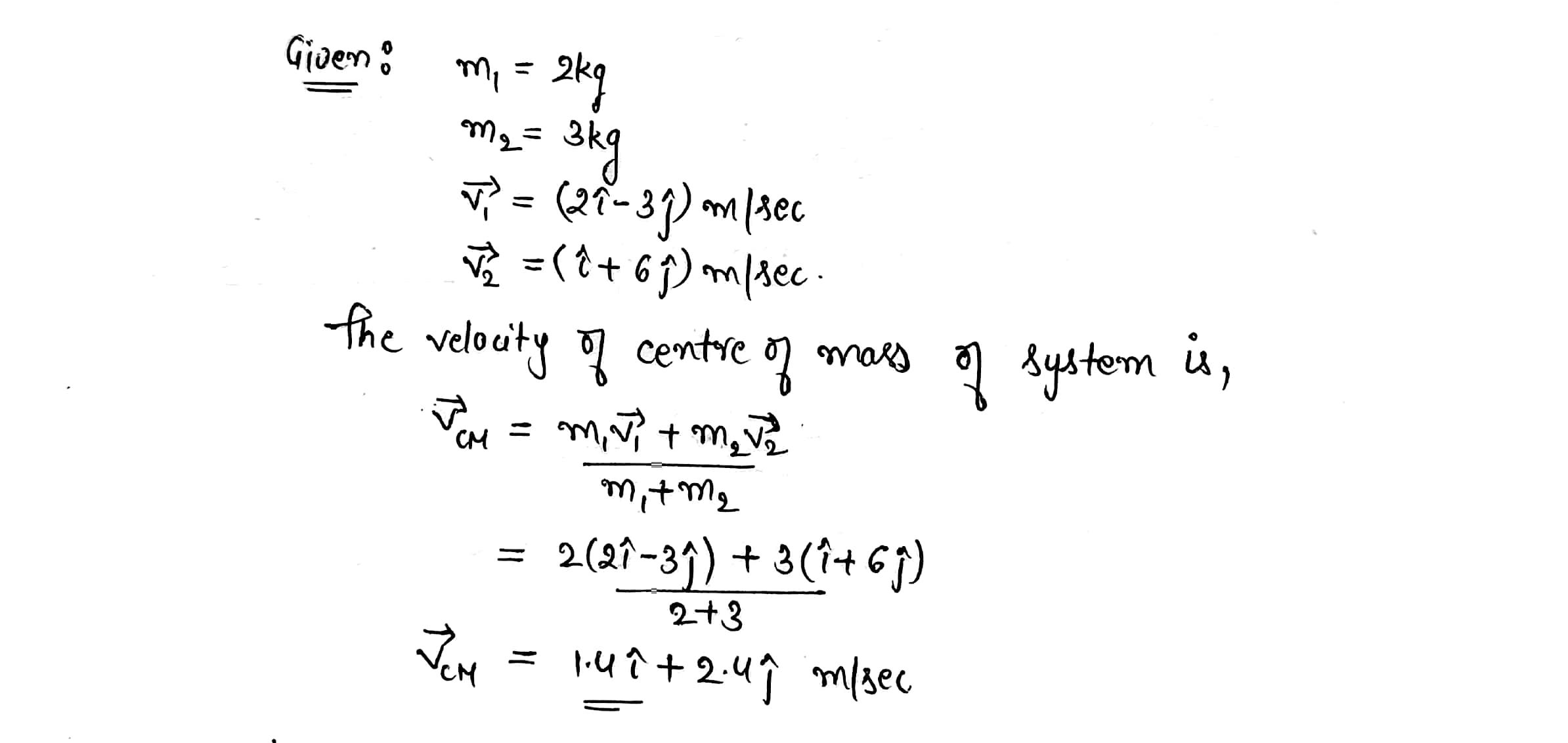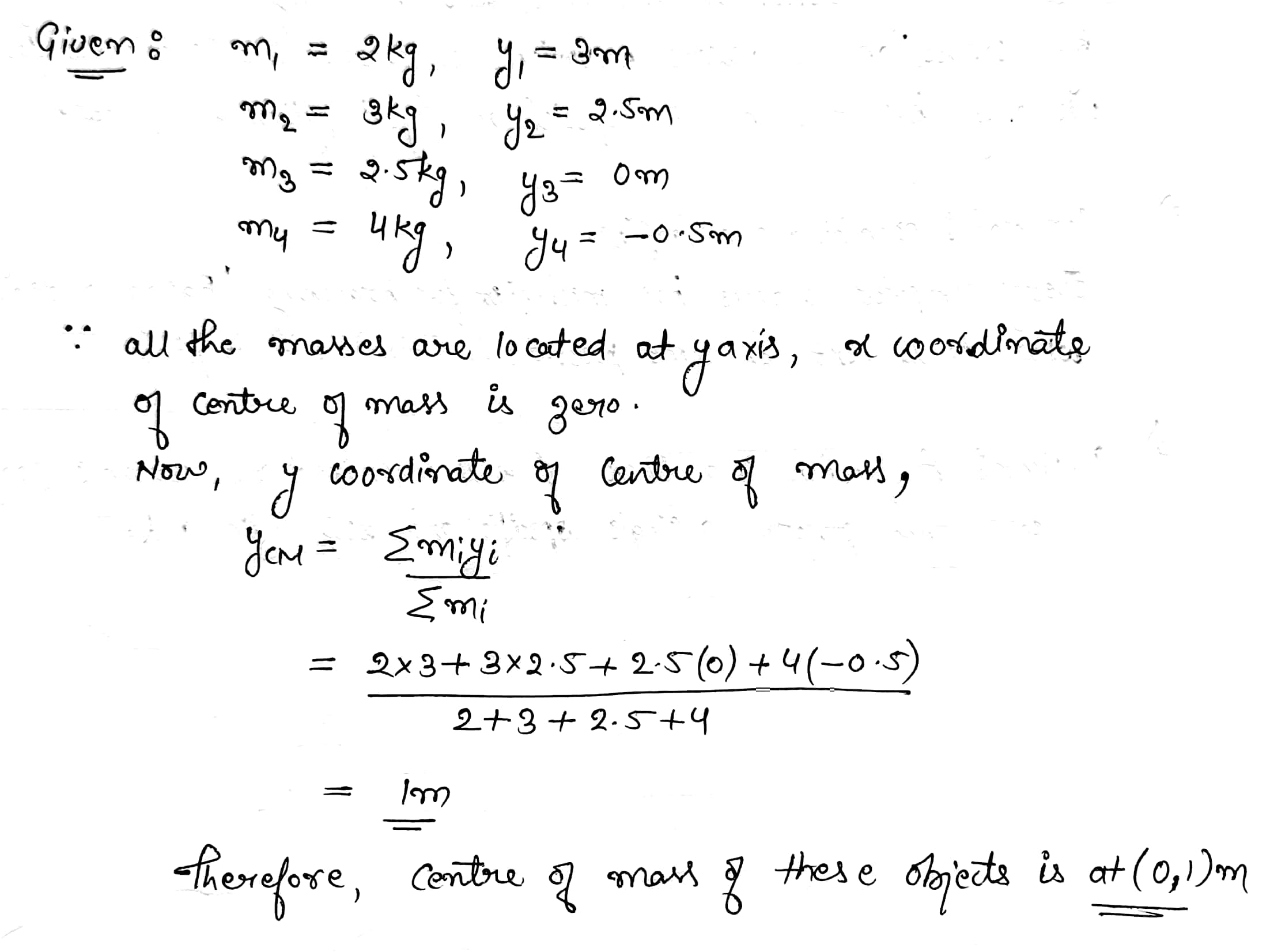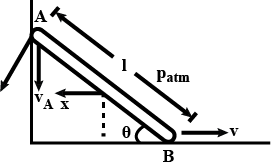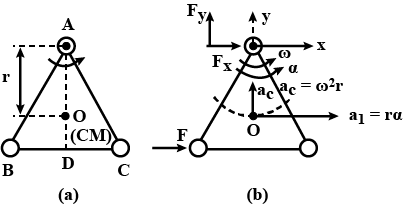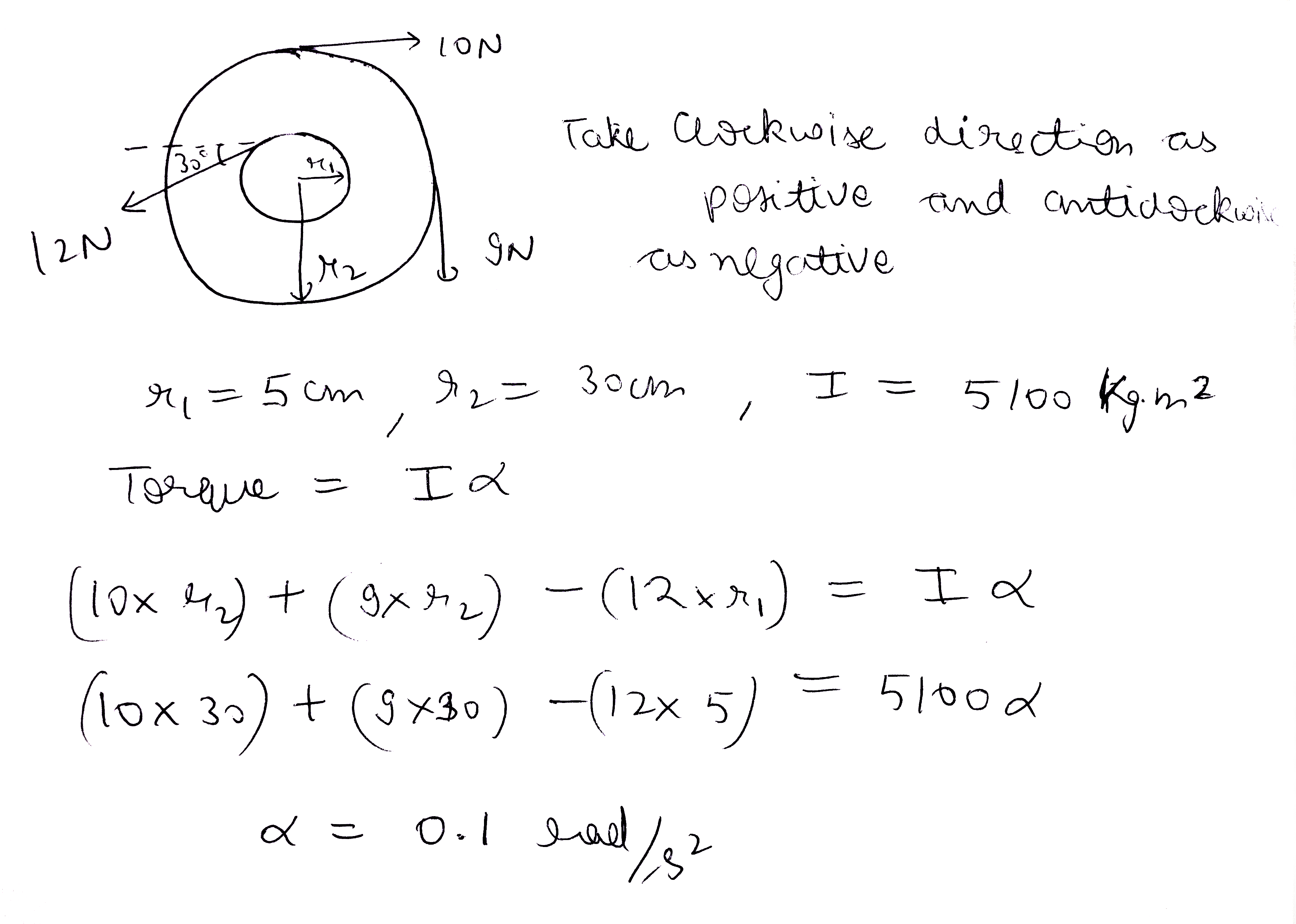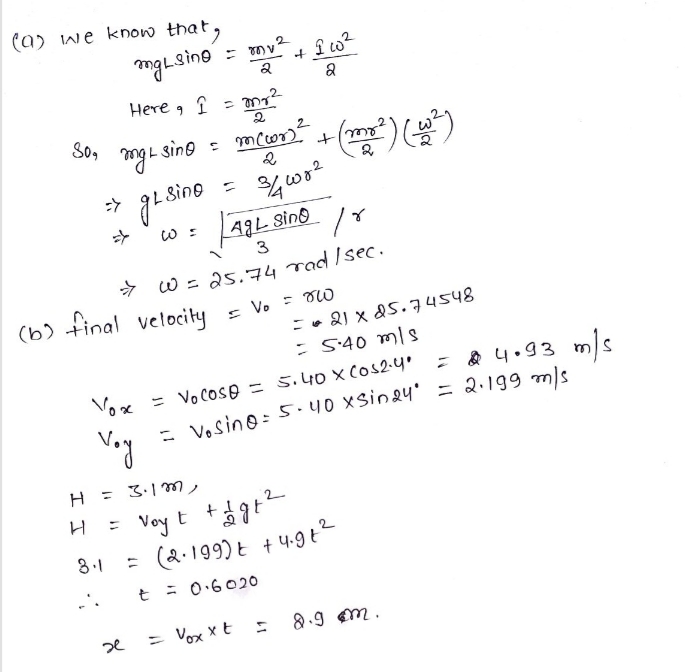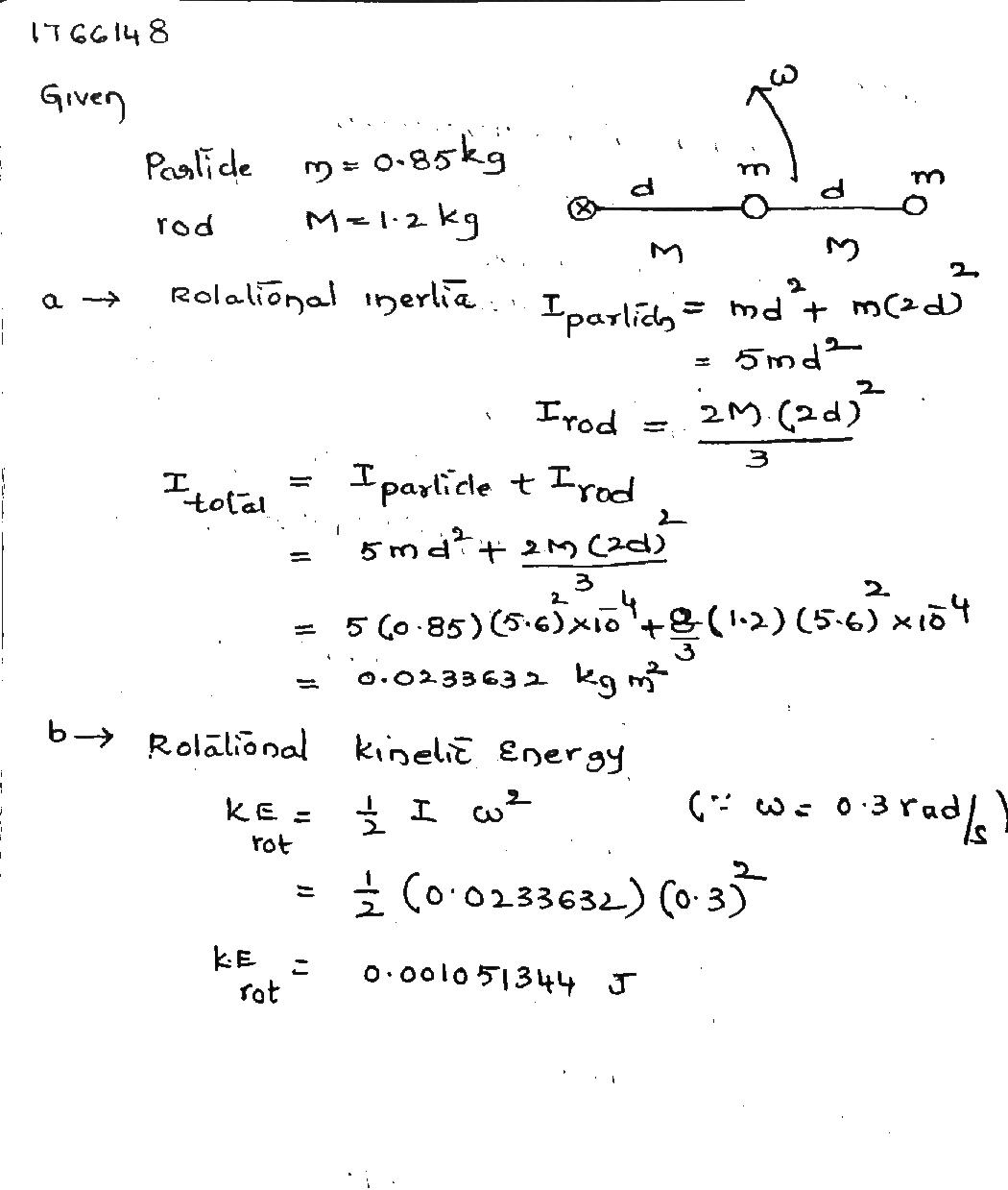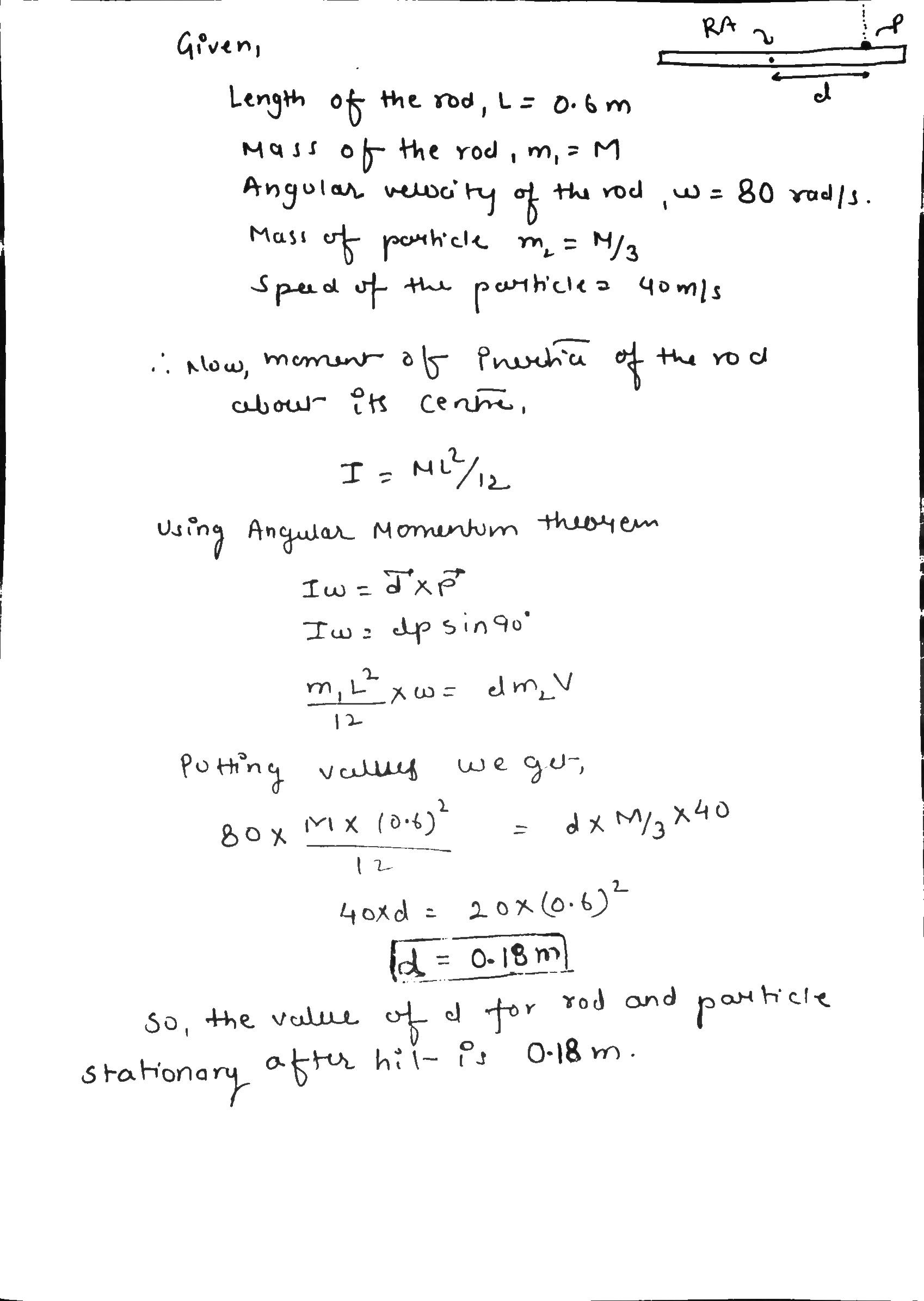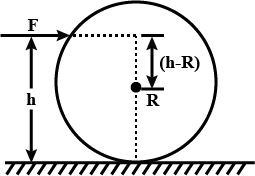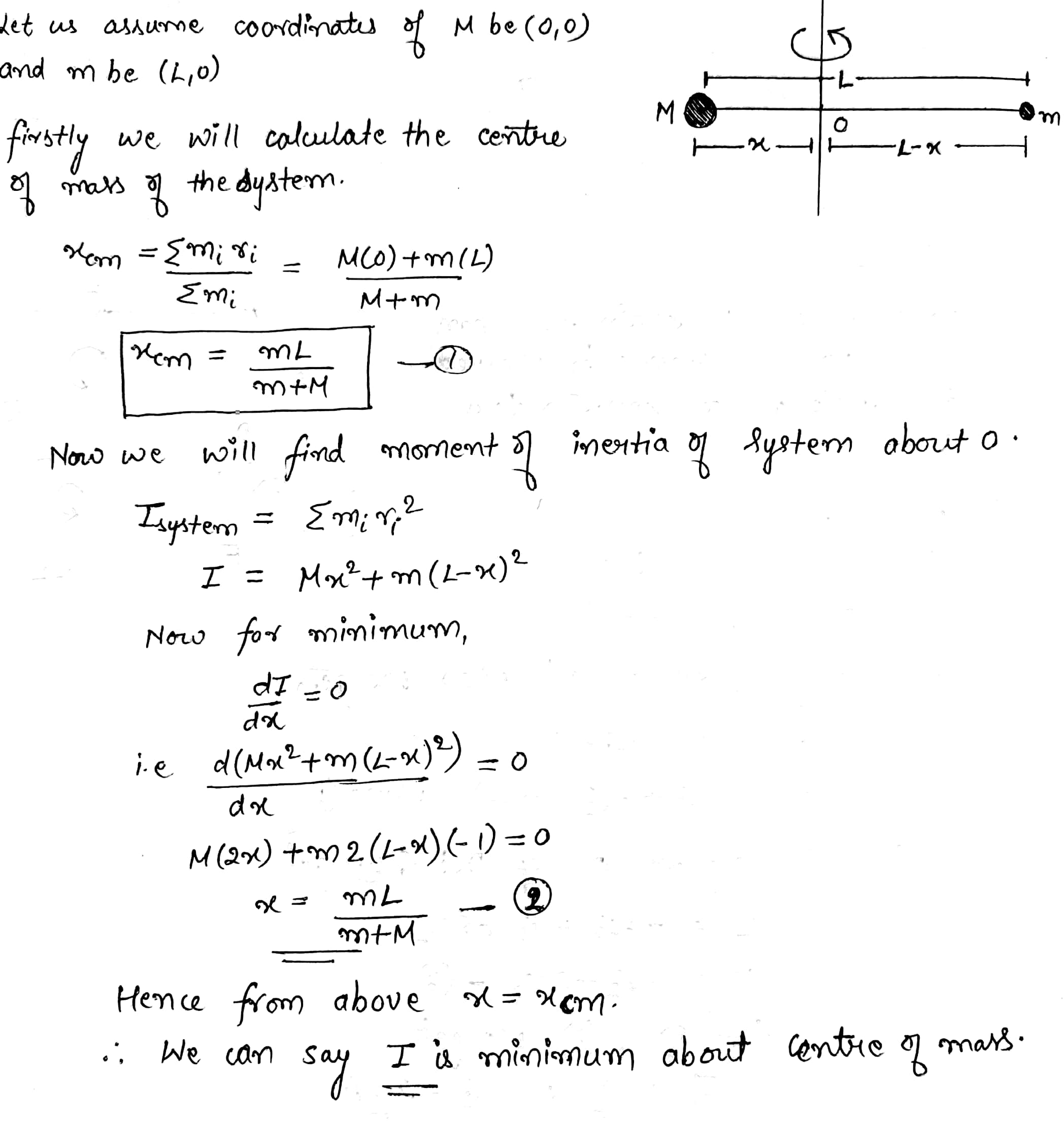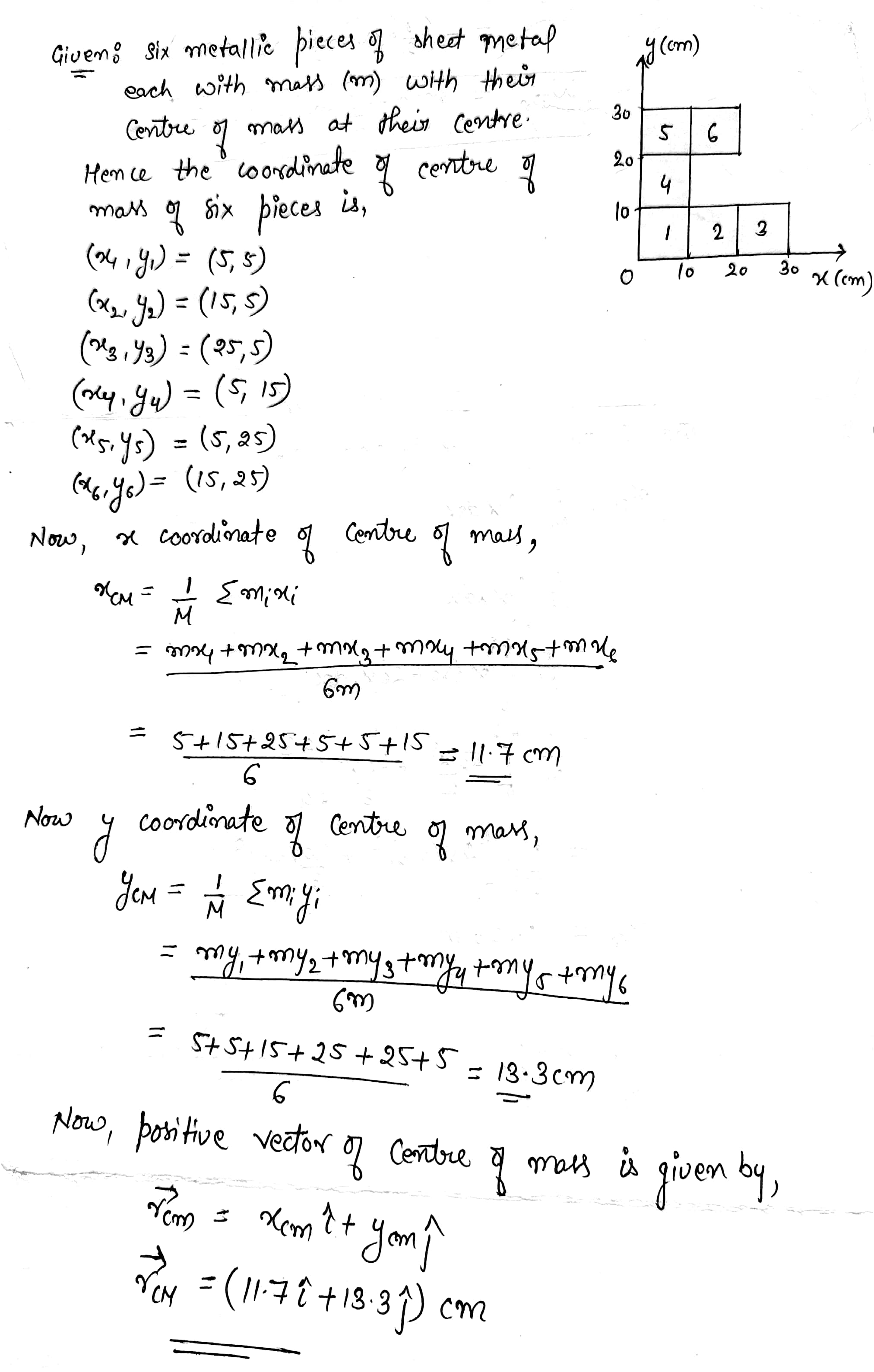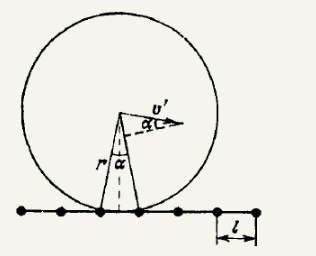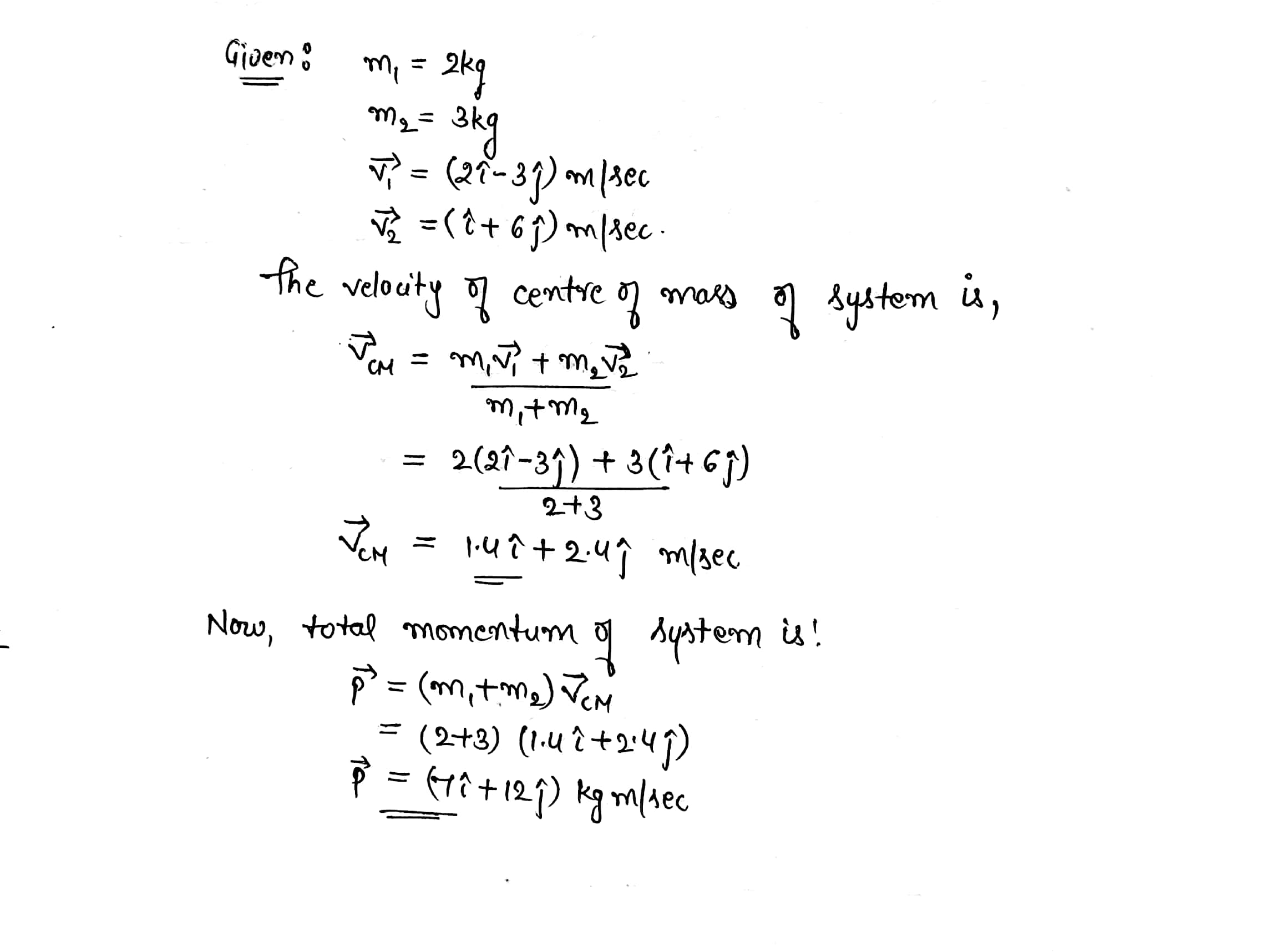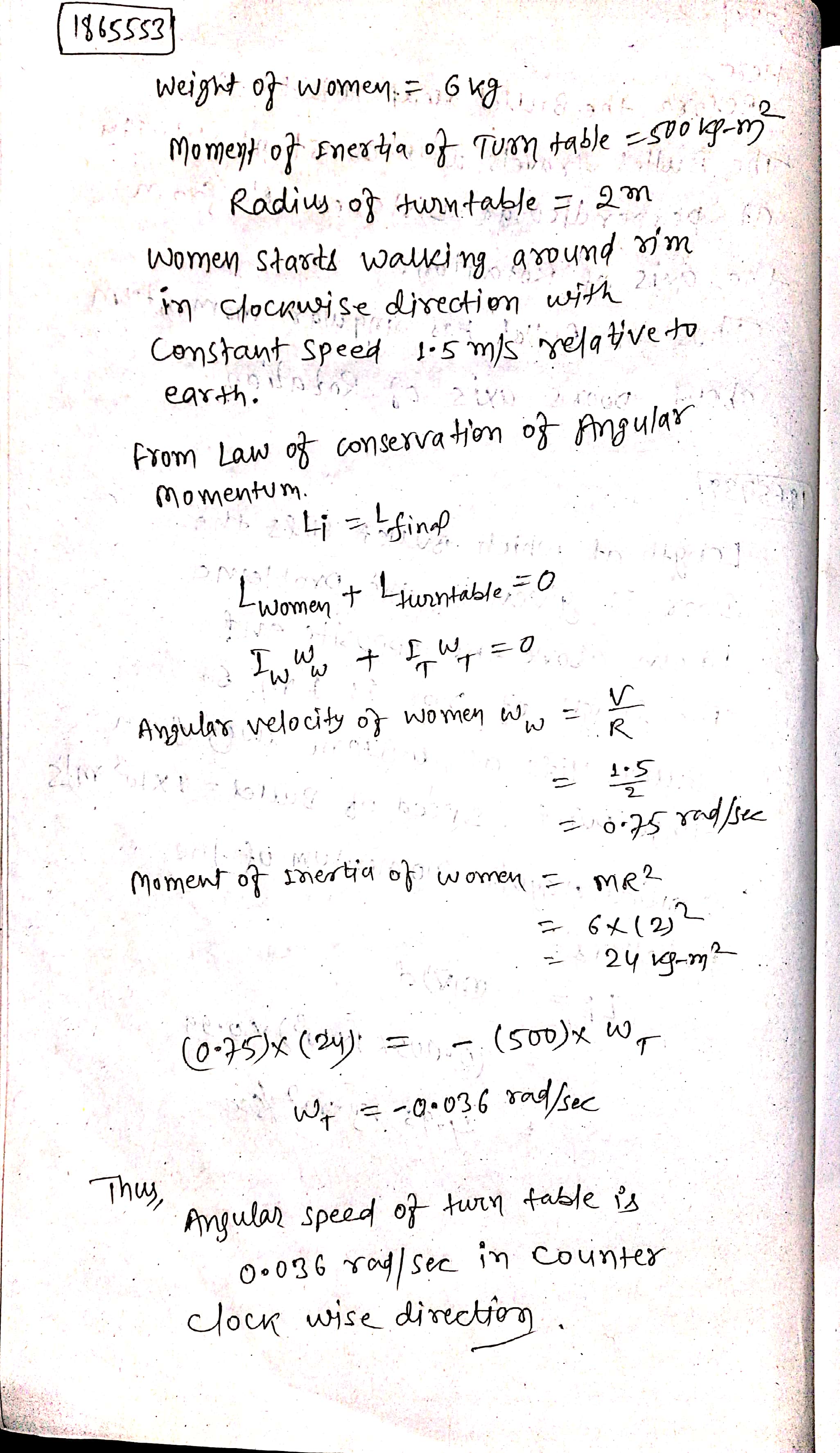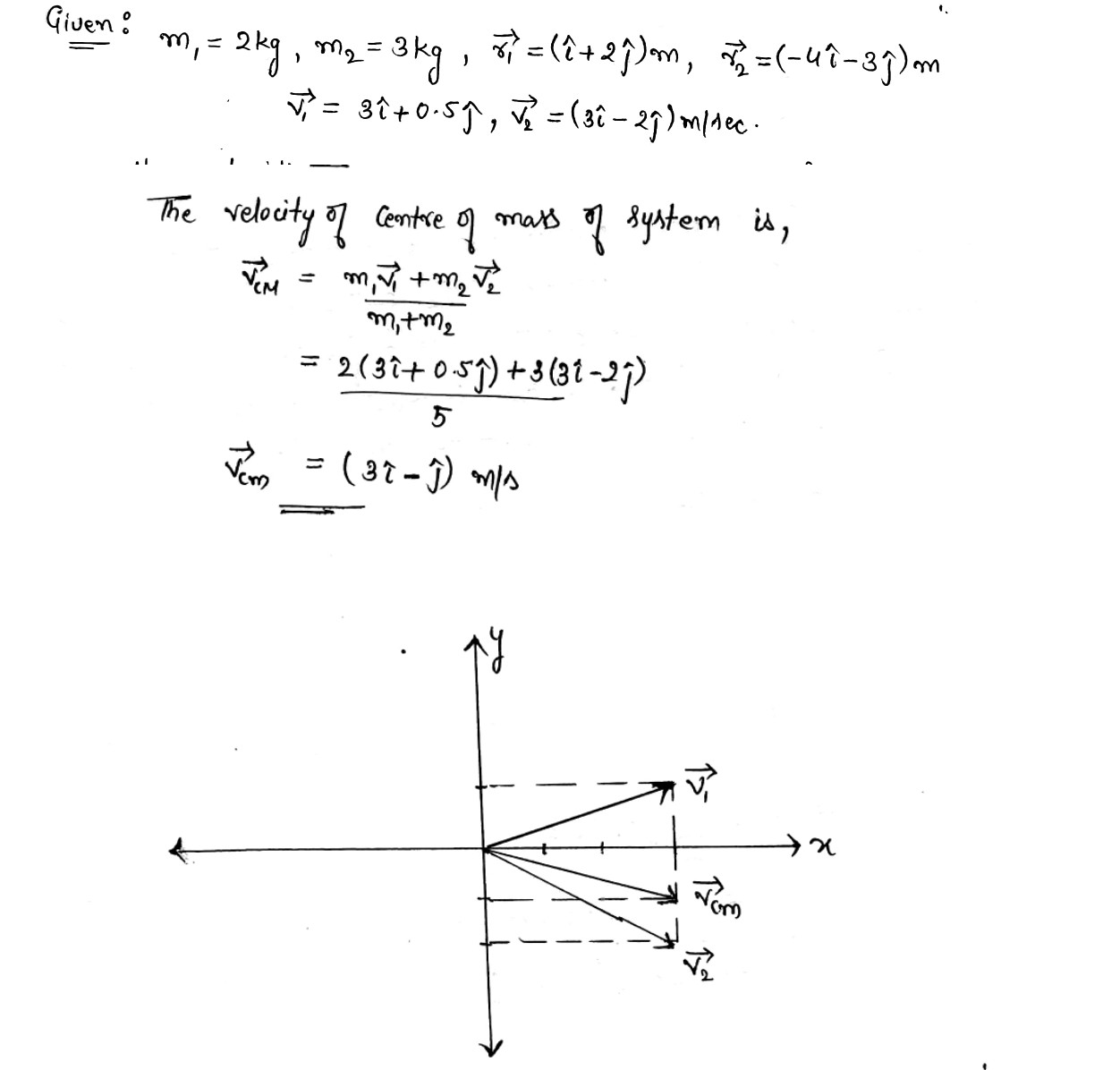Systems Of Particles And Rotational Motion - Class 11 Medical Physics - Extra Questions
what is the inertial mass?
What is centre of mass?
Differentiate between stable and unstable equilibrium.
If momentum of a body increases by 50% by what % its K.E. change?
Write the value of radius of gyration of a solid sphere relative to its tangent.
Define center of mass.
A locomotive is propelled by a turbine whose axle is parallel to the axes of wheels. The turbine's rotation direction coincides with that of wheels. The moment of inertia of the turbine rotor relative to its own axis is equal to I=240kg⋅m2. If the additional force exerted by the gyroscopic forces on the rails when the locomotive moves along a circle of radius R=250m with velocity v=50km/h is Fadd=x10kN.m, find the value of x. The gauge is equal to l=1.5m. The angular velocity of the turbine equals n=1500rpm.
Find the moment of inertia of the two uniform joint rods having mass m each about point P as shown in figure. Using parallel axis theorem.
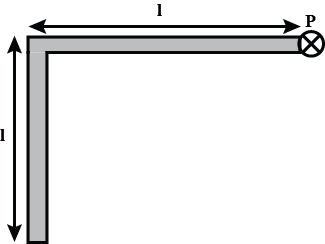
Find the radius of gyration of a solid uniform sphere of radius R about its tangent.
Calculate the moment of inertia of a uniform rod of mass M and length l about an axis 1,2,3 and 4.
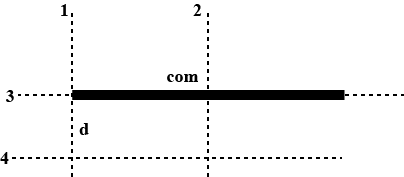
Differentiate between Rolling motion and Random motion.
A wheel of radius r rolls (rolling without slipping) on a level road as shown in figure. Angular velocity of the wheel is ω, as shown in figure. Find out velocity of point A and B.
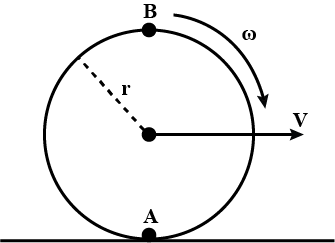
(i) On what factor does the position of the centre of gravity of a body depend?
(ii) What is the S.I.unit of the moment of force?
What are the sign conventions for anticlockwise and clockwise rotations of moment?
A non - uniform thin rod of length ℓ lies along the x-axis with one end at the origin. It has a linear mass density λ kg/m, given by λ =λ0 (1+x/ℓ ). Find the center of mass of the rod.
A rod of length l is standing vertically frictionless surface. It is disturbed slightly from this position. Let ω and α be the angular speed and angular acceleration of the rod, when the rod turns through an angle θ with the vertical, then find the value of acceleration of centre of mass of the rod.
A mass ′m′ moves with velocity v=√3m/s and collides with another mass 2m initially at rest. After collision first mass move with velocity v√3 in the direction perpendicular to initial direction of motion. Speed of second mass (in m/s) after collision is ____________.
From a uniform disk of radius R, a circular hole of radius R/2 is cut out. The centre of the hole is at R/2 from the centre of the original disc.Locate the centre of gravity of the resulting flat body.
Can a body in translatory motion have angular momentum? Explain.
A tangential force F acts at the top of a thin spherical shell of mass m and radius R. Find the acceleration of the shell if it rolls without slipping.
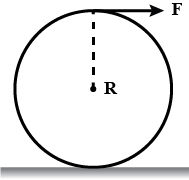
A uniform cylinder of radius R is spinned about its axis to the angular velocity ω0 and then placed into a corner. The coefficient of friction between the corner walls and the cylinder is μk. How many turns will the cylinder accomplish before it stops?
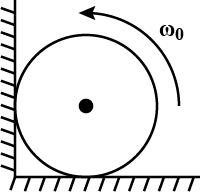
Why is it easier to roll a gas cylinder than to pull it along the road?
A steering wheel of diameter 0.5 m is rotated anticlockwise by applying two forces each of magnitude 5 N. Draw a diagram to show the application of forces and calculate the moment of couple applied.
A block of mass m is placed on a triangular block of mass M, which in turn is placed on a horizontal surface as shown in figure. Assuming frictionless surfaces find the velocity of the triangular block when the smaller block reaches the bottom end.
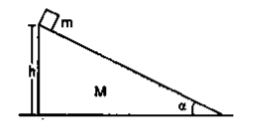
Find (1) radius of gyration (2) M.I of a rod of mass 100g & length 100 cm about an axis passing through its centre & to its length.
A thin rod of the length L is suspended from one end and rotates with n rotation per second the rotational kinetic energy of rod will be?
Two identical uniform rod each of mass m and length t joined perpendicular to each other . An axis passes through junction and in the plane of rods. Then M of system about the axis is.
Initially stable two particles x and y start moving towards other under mutual attraction. If at one time the velocities of X and Y are V and 2V respectively, what will be the velocity of centre of mass of the system?
What is the MOI of the following

Two rods OA and OB of equal length and mass are lying in xy plane as shown in figure. Let Ix,Iy and Iz be the moment of inertia of both the rods about x, y and z axis respectively. Then?
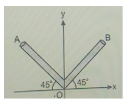
Motion of centre of mass
What do you understand by the clockwise and anticlockwise moment of force? When is it taken positive?
A meter stick is balanced on a knife edge at its centre. When two coins each of mass 5g are put one on top of the other at 12.0cm mark, the stick is found to be balanced at 45.0cm. What is the mass of the meter stick?
Four identical thin rods each of mass M and length l , form a square frame . Form of inertia of this frame about an axis through the centre of the square and perpendicular to its plane is :
Define radius of gyration.
Define the term moment of force .
What will be the moment of inertia of a thin rod of mass M and length l along the axis perpendicular to its length and passing through one point from a distance l /4 from one end.
Three particles of masses 1.0kg, 2.0kg and 30kg are placed at the corners A,B and C respectively of an equilateral triangle ABC of edge 1m. Locate the centre of mass of the system.
The variation of angular position θ, of a point on a rotating rigid body, with time t is shown in Figure. Is the body rotating clock-wise or anti-clockwise?
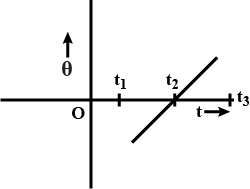
Write the conditions for mechanical equilibrium of rigid bodies.
Calculate the moment of inertia of a thin rod about an axis perpendicular to the length and passing through one edge.
Write down the relation between angular momentum, moment of inertia and angular velocity.
Establish the relation between angular momentum and angular velocity.
Answer in brief:
A big dumb-bell is prepared by using a uniform rod of mass 60g and length 20cm. Two identical solid spheres of mass 50g and radius 10cm each are at the two ends of the rod. Calculate the moment of about an axis passing through its center and perpendicular to the length.
A metallic ring of mass 1kg has a moment of inertia 1kgm2 when rotating about one of its diameters. It is molten and remolded into a thin uniform disc of the same radius. How mush will its moment of inertia be , when rotated about its own axis.
State the law of moments.
Write expression for moment of inertia of thin rod
Figure is an over head view of a thin uniform rod of length 0.600 m and mass M rotating horizontally at 80.0 rad/s counterclockwise about an axis through its center. A particle of mass M/3.00 and traveling horizontally at speed 40.0 m/s hits the rod and sticks. The particle's path is perpendicular to the rod at the instant of the hit, at a distance d from the rods center.
In which direction do rod and particle rotate if d is greater than this value?
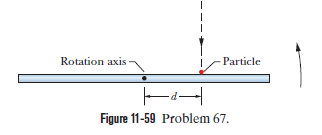
Five bodies 1kgwt.,2kgwt.,3kwt.,4kgwt. and 5kgwt. are suspended at a distance of 1m,2m,3m,4m, and 5m from one end of a uniform rod of mass 4kg and 6 meters length. Find the point about which the rod will balance about the knife edge placed at a distance of ′X′ from the end A.
The figure illustrates the position and masses of 3 particles. Find the position of their centre of mass.
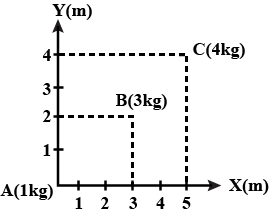
Consider a system of two particles in the xy plane: m1=2.00 kg is at the location →r1=(1.00ˆi+2.00ˆj)m and has a velocity of (3.00ˆi+0.500ˆj) m/s;m2=3.00 kg is at →r2=(−4.00ˆi−3.00ˆj) m and has velocity (3.00ˆi−2.00ˆj) m/s.
Plot these particles on a grid or graph paper.
What is the total linear momentum of the system?
A 2.00−kg particle has a velocity (2.00ˆi−3.00ˆj) m/s, and a 3.00−kg particle has a velocity (1.00ˆi+6.00ˆj) m/s. Find
the velocity of the center of mass
Four objects are situated along the y axis as follows: a 2.00−kg object is at +3.00 m, a 3.00−kg object is at +2.50 m, a 2.50−kg object is at the origin, and a 4.00−kg object is at −0.500 m. Where is the center of mass of these objects?
Calculate the resultant torque from the following diagram:
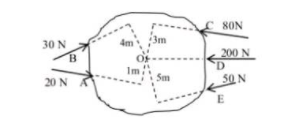
What is the minimum coefficient of friction required to maintain pure rolling motion for the disk?
The end B of uniform rod AB which makes angle θ with the floor is being pulled with a velocity v0 as shown. Taking the length of rod as l, calculate the following at the instant when θ=37∘.
(a) The velocity of end A
(b) The angular velocity of rod
(c) Velocity of CM of the rod.
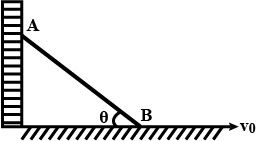
Write the equation corresponding to the ones given, for rotational motion about a fixed axis.
(i)×(t)=x(0)+v(0)t+1a/2 t2
(ii) v2(t)=v2(0)+2a[x(t)−x(0)]
(iii) ˉv=v(t)−v(0)2
(iv) v(t)=v(0)+at
Two masses, nm and m, start simultaneously from the intersection of two straight lines with velocities ν and nν respectively. It is observed that the path of their bisecting the angle between the given straight lines. Find the magnitude of the velocity of centre of mass. [Here θ= angle between the lines].
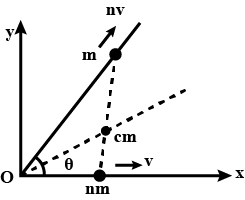
A block of mass M with a semi-circular track of radius R, rests on a horizontal frictionless surface. A uniform cylinder of radius r and mass m is released from rest at the top point A (See fig.). The cylinder slips on the semicircular frictionless track. How far has the block moved when the cylinder reaches the bottom (point B) of the track? How fast is the block moving when the cylinder reaches the bottom of the track
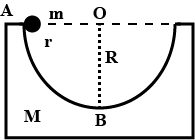
Three particles A,B,C each of mass m are connected to each other by three massless rigid rods to form a rigid, equilateral triangular body of side l. This body is placed on a horizontal frictionless table (x-y plane) and is hinged at point A so that it can move without friction about the vertical axis through A. The body is set into rotational motion on the table about this axis with a constant angular velocity ω (a) Find the magnitude of the horizontal force exerted by the hinge on the body (b) At time T, when side BC is parallel to x-axis, force F is applied on B along BC (as in the figure). Obtain the x-component and the y-component of the force exerted by the hinge on the body, immediately after time T.
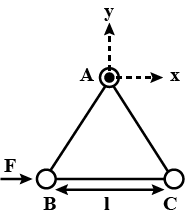
If the radius of solid sphere is 35 cm calculate the radius of gyration when the axis is along a tangent
A uniform meter rule balances horizontally on a knife-edge placed at the 60 cm mark when a weight of 1 g is suspended from one end. What is the weight of the rule?
In the following figure r1 and r2 are 5 cm and 30 cm respectively. If the moment of inertia of the wheel is 5100 kg−m2 about the axis passing through its centre and perpendicular to the plane of wheel, then what will be its angular acceleration?
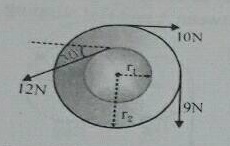
A uniform steel rod of 1m in length is bent in a 90∘ angle at its mid point. Determine the position of its center of mass from the corner at bent.
A body of mass M and radius r rolling on a smooth horizontal floor with velocity v, rolls up an irregular inclined plane(sufficiently rough) up to verticle height (3v2/4g) compute the moment of inertia of the body.
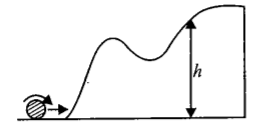
Each object shown in column I has mass 2m. The ring has mass m and radius R. The other components rod, lamina have total mass m. The shaded part in any figure represent a lamina axis I and II are in plane of figure, moment of inertia about their axis is represented by I1,I2. Moment of inertia about axis through O and perpendicular to plane of figure is given by I0.
In figure a solid cylinder of radius 10 cm and mass 12 kg starts from rest and rolls without slipping a distance L=6.0 m down a roof that is inclined at angle θ=30o.
The roof's edge is at height H=5.0 m. How far horizontally from the roof's edge does the cylinder hit the level ground?
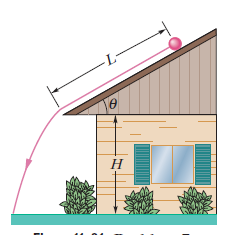
A vertical container with base area measuring 14.0 cm by 17.0 cm is being filled, with identical pieces of candy, each with a volume of 50.0 mm3 and a mass of 0.0200 g. Assume that the volume of empty spaces between the candies in negligible. If the height of the candies in the container increases at the rate of 0.250 cm/s, at what rate (kilograms per minute) does the mass of the candies in the container increase?
In fig.10.37 two particles each with mass m=0.85 kg , are fastened to each other , and to a rotation axis at O, by two thin rods, each with length d=5.6 cm and mass M=1.2 kg. The combination rotates around the rotation axis with the angular speed ω=0.30 rad/s. Measured about O, what are combination's (a) rotational inertia and (b) kinetic energy
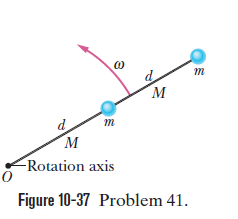
Figure is an over head view of a thin uniform rod of length 0.600 m and mass M rotating horizontally at 80.0 rad/s counterclockwise about an axis through its center. A particle of mass M/3.00 and traveling horizontally at speed 40.0 m/s hits the rod and sticks. The particle's path is perpendicular to the rod at the instant of the hit, at a distance d from the rods center.
At what value of d are rod and particle stationary after the hit?
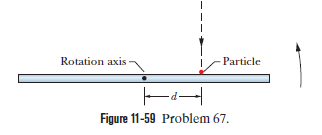
Two 2.00 kg balls are attached to the ends of a thin rod of length 50.0 cm and negligible mass. The rod is free to rotate in a vertical plan without friction about a horizontal axis through its center. With the rod initially horizontal, a 50.0 g wad of wet putty drops onto one of the balls, hitting it with a speed of 3.00 m/s and then sticking to it.
What is the ration of the kinetic energy of the system after the collision so that of the putty wad just before?
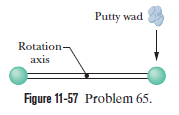
A uniform sphere of mass m and radius R is placed on a rough horizontal surface (Figure). The sphere is struck horizontally at a height h from the floor. Match the following:
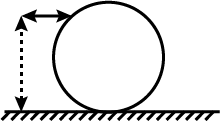
Two balls with masses M and m are connected by a rigid rod of length L and negligible mass as shown in Figure. For an axis perpendicular to the rod, show that the system has the minimum moment of inertia when the axis passes through the centre of mass.
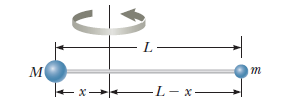
A uniform piece of sheetmetal is shaped as shown in Figure P9.48. Compute the x and y coordinates of the center of mass of the piece.

An inextensible rope tied to the axle of a wheel of mass m and radius r is pulled in the horizontal direction in the plane of the wheel. The wheel rolls without jumping over a grid consisting of parallel horizontal rods arranged at a distance l from one another (l≪r). Determine the average tension T of the rope at which the wheel moves at a constant velocity v, assuming the mass of the wheel to be concentrated at its axle.
A 2.00−kg particle has a velocity (2.00ˆi−3.00ˆj) m/s, and a 3.00−kg particle has a velocity (1.00ˆi+6.00ˆj) m/s. Find
the total momentum of the system.
A 6.00 kg woman stands at the western rim of a horizontal turntable having moment of inertia of 500 kg. m2 and a radius of 2.00 m. The woman then starts walking around the rim clockwise at a constant speed of 1.50 m/s relative to the Earth. Consider the woman turntable system as motion beings.
In what direction and with what angular speed does the turntable rotate?
Consider a system of two particles in the xy plane: m1=2.00 kg is at the location →r1=(1.00ˆi+2.00ˆj)m and has a velocity of (3.00ˆi+0.500ˆj) m/s;m2=3.00 kg is at →r2=(−4.00ˆi−3.00ˆj) m and has velocity (3.00ˆi−2.00ˆj) m/s.
Plot these particles on a grid or graph paper.
Determine the velocity of the center of mass and also show it on the diagram.
Class 11 Medical Physics Extra Questions
- Gravitation Extra Questions
- Kinetic Theory Extra Questions
- Laws Of Motion Extra Questions
- Mechanical Properties Of Fluids Extra Questions
- Mechanical Properties Of Solids Extra Questions
- Motion In A Plane Extra Questions
- Motion In A Straight Line Extra Questions
- Oscillations Extra Questions
- Systems Of Particles And Rotational Motion Extra Questions
- Thermal Properties Of Matter Extra Questions
- Units And Measurement Extra Questions
- Waves Extra Questions
- Work, Energy And Power Extra Questions

